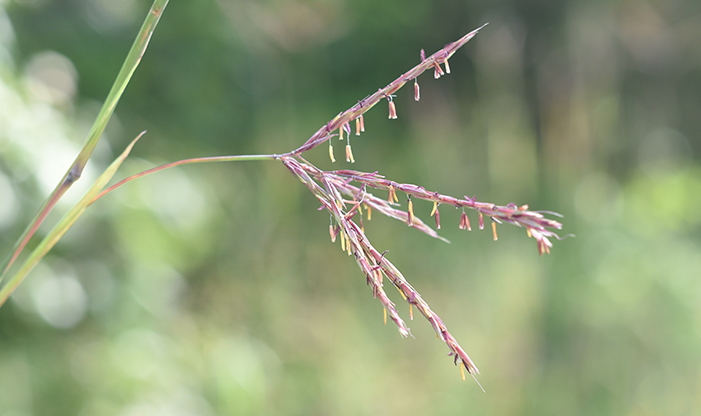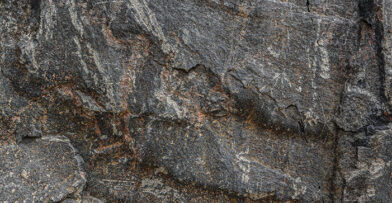Written with contributions from Aubrey Ellickson, Sandy Manning, and Don Quintenz
When people look at plants and trees, they often consider their beauty—the colors of their flowers, the shape of a tree or plant’s leaves, or their scent. One thing we might not consider is that the main purpose of a plant is to create a lineage that survives as long as possible. Plants use multiple strategies to accomplish this task. One strategy is to disperse their seeds in a way that enhances the species’ successful reproduction. Essentially, seeds are vessels that transport genetic material from one generation to the next, and using effective seed dispersal strategies is key for a plant’s survival.
Seed Dispersal Strategies at the Center
At the Center, you will see three dispersal strategies: wind, animal, and ballistic. Seeds that use the wind to travel away from the parent plant, called wind dispersal, include helicopters and floaty seeds. Helicopters from maple trees and the cottony fluff of Cottonwood are some of the most visible seeds of this kind. Animal dispersal involves using the nuts and fruits produced by plants and trees to get seeds to a suitable destination. Sticky seeds from plants like Jewel Weed also use animal dispersal, while plants that use ballistic dispersal techniques, like Witch Hazel, literally explode their seeds into the environment, sending them flying.
Riding the Wind
There is no limit to how far the wind can travel, and most people have seen the fluffy white tufts of Dandelion seeds floating on the breeze. The clusters of successful yellow flowers attest to the effectiveness of wind dispersal, even for a weed. Cottonwood fluff and the silky insides of Milkweed pods also ride the wind. Milkweed’s horn-shaped pods open up when the seeds are mature, and float on soft, silky material that looks like flossy threads. For Tumbleweed, the wind propels the entire top of the plant to drop its seeds.
Helicopters also follow the winds to find suitable growth habitat to germinate. Maple trees flood the environment with helicopter seeds, with a period of one to four years between crops in much of Wisconsin. The seeds mature about six weeks after flowering, after which they disperse by spinning to the ground like a propeller. Because Sugar Maple is the most shade tolerant tree in Wisconsin, these floods of seedlings will persist until canopy openings occur, and then fill the newly formed canopy opening; thus, Sugar Maple can maintain a dominant position in these forests.
Travelling with Animals
One way animal dispersal occurs is by animals eating the seeds found in nuts and fruits; both fruits and nuts are containers for seeds, and the animal assists the plant by passing the seed through its digestive tract and then dropping it. The acidic juices in the digestive tract cause the seed to undergo scarification, which is a way to prepare the seed for germination. It is then dropped in its own fertilizer.
Animals like to eat nuts, which taste good because of their fatty part. Oak trees will produce 10,000 acorns at a time every five years. Animals take more nuts than they eat and store them in caches, often moving them around, creating the necessary distance from the parent tree when they germinate. Even little creatures like ants spread seeds! Wild Ginger and Violet Trillium have fleshy, fatty elaiosomes attached to their seed; these elaiosomes are eaten by ants, who deposit the seeds with the rest of the nests waste products.
Seeds Animals Don’t Eat
Sticky seeds use animal dispersal by attaching themselves to animals passing by—the animal catches the seed on its body, then drops it a distance from the parent plant. Jewel Weed produces a sticky seed, which travels farther with the help of an animal. Sticky seeds don’t help the animal, because they don’t eat it, and this prevents animals from foraging on the plant for food. Nevertheless, the animal helps the plant by spreading its genetic material.
Pods are a type of fruit that animals don’t eat. The plant surrounds this seed with a protective casing, in this case a pod, similar to what plants do with edible fruit, and then the pod opens to release seeds. Baptisia, also called Wild Indigo, produces seeds in a pod that forms after the flowers bloom.
The pods ripen in fall turning dark brown to black, then the seeds ripen and release from their attachment to rattle around in the pods. In winter, the dry winter air causes the seam in the pods to split and the seeds to bounce out as the wind rattles the stems
Ballistic Travel Strategies
One dramatic form of seed travel is ballistic dispersal, which is the explosive release of the seeds by the fruit. Witch Hazel’s flowers exist on the plant alongside the maturing fruit from the previous season. The fruit has two woody capsules, each one containing a seed, and in the autumn, the capsule splits and explodes, throwing the seeds up to 30 feet.
Exploding works well in combination with other methods, as plants need their seeds to travel a fair distance for reproduction to be effective. When too many plants of the same species germinate and grow in clusters, they compete. Effective dispersal strategies help seeds travel away from the parent plant to areas more suitable for growth, so plants will often use combined techniques to send out their seeds and maximize the chance of a successful outcome.
In the fall, some seeds are windblown as well as assisted by animals. Jewel Weed produces a pod that explodes when touched, sending the seeds in all directions. The seeds are sticky, so they travel even farther on an animal.
Maple seeds travel on the wind by using their wings, but they are also tasty to animals. Animals who eat maple seeds will store them, but will not eat all of them, and the uneaten seeds will germinate some distance from the parent plant.
Travelling with Humans
We must not forget one ubiquitous dispersal mechanism that has a huge impact on the environment— humans. Sticky seeds attach to people and to the shoes and boots of people walking in the forest. Since people can travel a long distance, seeds often are sent many miles away from their original location. This is one way invasive species spread.
Fall is a great time to witness the succession of generations. Looking at colorful flowers and seeing the overall beauty of plants and trees while hiking at the Center, we can also be mindful of the purposeful underlying survival strategies used by them to propagate. It’s all part of the magic of seed dispersal.


